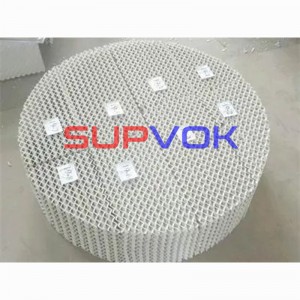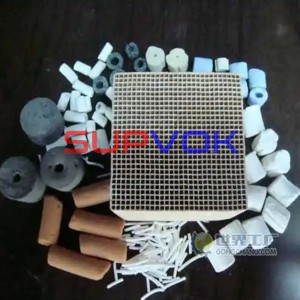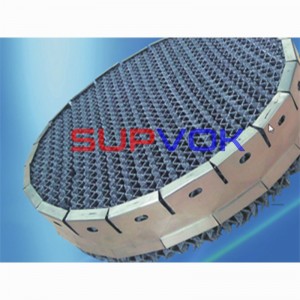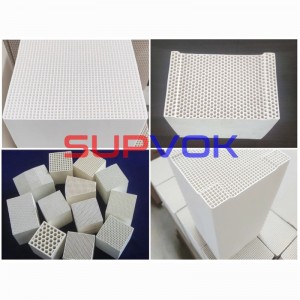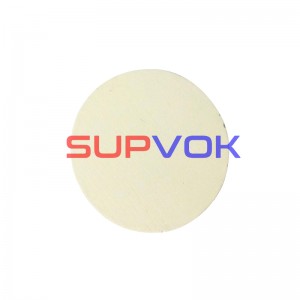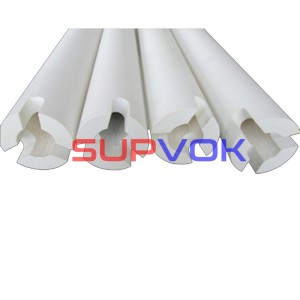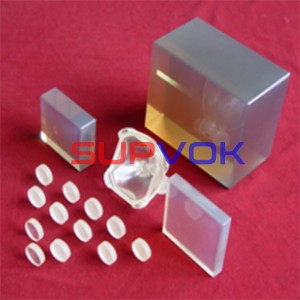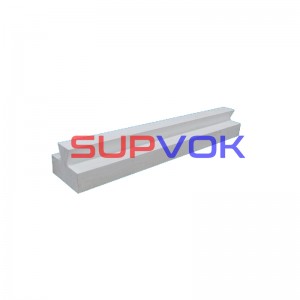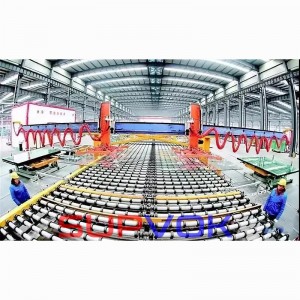Special Ceramic Chemical Tower Packing
How to select the filler for packed tower?
The selection of filler is to confirm the type of filler, specification, materials and so on. The selected filler should not only meet the requirements of production techniques, but also minimize the equipment investment and operating costs.
- 1,Selection of filler type
The selection of filler type shall consider the requirements of separation technique. Generally speaking, there are following aspects to be considered:
(1) In general, the mass transfer efficiency of structured packing is higher than that of bulk packing.
(2) The flux should be large.
On the premise of ensuring high mass transfer efficiency, the filter with high flooding point gas velocity or gas phase kinetic energy factor shall be selected.
(3) The pressure drop of the filter layer should be low.
(4) The filter has strong anti fouling performance., which is easy to disassemble and repair.
- 2,Selection of filler specifications
The filler specification refers to the nominal size or specific surface area of the filler.
(1) Selection of Bulk Filler Specifications
The commonly used bulk fillers for industrial tower mainly include DN16, DN25, DN38, DN50, DN76 and other specifications. The smaller the size of fillers is, the higher the separation efficiency will become. However, the resistance increases and the flux decreases, which will increase the cost of filler. When the large sized filler is used in packed tower with small diameter, it will cause poor liquid distribution and serious wall flow, which will reduce the separation efficiency of tower. Therefore, the ratio of tower diameter to filler size should be specified. Generally, the ratio D/d of tower diameter to nominal diameter of filler should be greater than 8.
(2) Selection of structured filler’s specification
There are many methods to express the model and specification of regular fillers commonly used in industry. It is customary to use specific surface area to express, such as 125, 150, 250, 350, 500, 700 and other specifications. Considering the regular packing of same type, the larger the specific surface area is, the higher the mass transfer efficiency will become. However, it will increase the resistance and decrease the flux, which will increase the filler cost significantly. During selection, it needs to make integrative consideration on separation requirements, flux requirements, site conditions, comprehensively properties, equipment investment, operating costs and other aspects. Thus, the selected filler can not only meet the technical requirements, but also be economically reasonable.
It should be pointed out that the same type and specification of filler can be selected for a packed tower, or the same type and different specifications of filler can be selected for the packed tower. In addition, it can also select the same type of filler can be selected, or different types of filler. Some tower sections can use regular filler, while some tower sections can use bulk filler. Thus, the design shall be flexible. The specification of filler shall be selected according to the principle of technical and economic unity.
- 3,Selection of filler material
The filler materials are divided into three categories: ceramic, metal and plastic.
(1) Ceramic filler
Ceramic filler has good corrosion-resistant and heat-resistant performance. It has low level price and good surface wettability. However, the brittleness and fragility are its biggest shortcomings. It is commonly presented in gas absorption, gas washing, liquid extraction and other processes.
(2) Metal filler
Metal filler can be made of various materials. In selecting the metal fillers, the corrosion is the main consideration. Carbon steel filler has low cost and good surface wettability. Thus, it should be preferred for non corrosive or low corrosive materials. Stainless steel filler has strong corrosion resistance. In general, it can resist the corrosion of common systems other than C -. However, stainless steel filler has high cost and relatively poor surface wettability. In some special occasions (such as vacuum distillation process under extremely low spray density), its surface needs to be treated to obtain good use effect. The fillers which are made of titanium materials, special alloy steel and other materials are usually very expensive. Generally, they are only used in some highly corrosive systems. Generally speaking, metal filler can be made into thin wall structure. It has large flux, small gas resistance, and high impact resistance. The steel filler can be used under high temperature, high pressure, and high impact strength. Their range of applications is large in the world.
(3) Plastic filler
The materials of plastic fillers mainly include polypropylene (PP), polyethylene (PE) and polyvinyl chloride (PVC). In China, the popular materials should be PP. The plastic filler has good corrosion resistance, which can resist the corrosion of ordinary inorganic acid, alkali and organic solvent. It has good temperature resistance. Thus, the plastic filler can be used under 100 degree for a long time. Plastic filler is light and cheap, while it has good toughness, good impact resistant performance. Especially, the plastic filler is not fragile, which can be made into thin-walled structures. It has large flux and low pressure, which is mainly used in absorption, desorption, extraction, dust removal and other devices. The disadvantage of plastic filler is its poor surface wettability. However, its surface wettability can be improved by proper surface treatment.
Details
Ceramic corrugated filler is a new type of structured filler which is composed of many filler units with the same geometric shape. Depending on the unique structure and good hydrophilicity, its surface can form turbulence of extremely thin liquid film and inclined zigzag channel of air flow, which can promote the air flow without blocking the air flow, so that the ceramic filler can compete with the metal filler. However, its corrosion resistance and high temperature resistance can not be compared with metal filler. Due to its good wettability, the surface structure can accelerate the liquid flow and reduce the liquid stagnation of filler to a low level, so that it reduces the possibility of overheating, polymerization and coking.
Ceramic corrugated filler has high separation efficiency, rough and porous ceramic surface and good capillary effect. The filler surface can be effectively wetted even in an aqueous solution system. The efficiency of Kerapak filler is similar to that of wire mesh corrugated filler (BX type). Under working load (F=15~2.0), there are 4~5 theoretical plates per meter of filler. The separation efficiency increases with decreasing load and increasing vacuum degree. Melladur filler also has a higher theoretical order. SK470 filler can provide 5~6 theoretical plates per meter, and has greater operating flexibility. 400 filler can maintain a stable separation efficiency in a large operating range.
The difference between the latter types of filler and the Kempak filler is that with the increase of vacuum degree and the decrease of F factor. Their separation efficiency has decreased. Compared with the metal corrugated filler, the ceramic plate corrugated filler is thicker and the filler’s porosity is lower. Thus, the pressure drop is larger; the flooding point is lower; the flux is smaller; and the liquid holding capacity is larger.
The main application scope of ceramic corrugated filler is in the following
1 Distillation absorption (intermediate absorption) of corrosion mixture with certain requirements on pressure drop and theoretical plate number;
2 Vacuum operation with absolute pressure above 100Pa;
3 It is used in special steel, glass and enamel towers. stainless steel, glass and graphite are commonly used to manufacture tower internals;
4 Distillation of halogenated organic compounds is the main application scope;
5 It can be used as heat exchanger, demister or catalyst carrier;
The light ceramic corrugated filler reduces the load of the tower and is suitable for the transformation of large towers. It is worth noting that suitable fillers should be selected in the presence of a large amount of hydrous inorganic acids and lyes. In addition, there are still some shortcomings such as heavy weight and inconvenient assembly, disassembly and cleaning.
Specific Application of Ceramic Corrugated Filler
Ceramic corrugated filler is a new type of structured filler, which is composed of many filler units with the same geometric shape. Depending on the unique structure and good hydrophilicity, its surface can form turbulence of extremely thin liquid film and inclined zigzag channel of air flow, which can promote the air flow without blocking the air flow, so that the ceramic filler can compete with the metal filler. However, its corrosion resistance and high temperature resistance can not be compared with metal filler. Due to its good wettability, the surface structure can accelerate the liquid flow and reduce the liquid stagnation of filler to a low level, so that it reduces the possibility of overheating, polymerization and coking.
Specific application of ceramic corrugated filler:
1 The distillation of halogenated organic compounds has strict requirements on pressure drop and theoretical number of plates, such as distillation and absorption of corrosive mixtures and so on.
2 It can be used in the tower with large amount of natural medium, such as sulfuric acid absorption, nitric acid concentration and gas purification of fertilizer plant.
3 Vacuum operation with absolute pressure from 100Pa.
4 It can be used as heat exchanger, demister or catalyst carrier.
In addition to the above products, the company also supplies ceramic balls, ceramic fillers and other products. KSINO has professional technology and professional operation team to create services based on user experience. The perfection of service is our endless pursuit.
Due to the people-oriented, we are trustworthy.
Due to full-time specialty, we are worth to be chosen.
The above information is only for reference. Please call to get more information.
High efficiency ceramic corrugated filler
Reinforced porcelain corrugated filler
Ceramic tower internals
Φ 800 high-efficiency ceramic redistributor
Φ In 600mm multi tube ceramic distributor
Φ 1000 ceramic distributor
Φ 1000 ceramic distributor
Φ 900 high-efficiency ceramic distributor
Φ 1000 ceramic liquid collector trough distributor
Ceramic support grid
Catalyst carrier
Distributor
Ceramic distributor
Ceramic sieve plate
Overflow ceramic distributor





